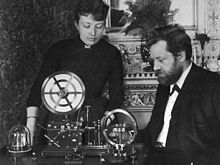Hilda Ericsson

Hilda Carolina Ericsson (born August 3, 1860 as Hilda Simonsson in Stockholm , Sweden ; † January 3, 1941 ibid) founded the Swedish telecommunications company Ericsson together with her husband Lars Magnus Ericsson . Her area of responsibility was developing and testing new inventions and products as well as managing the company, especially in the absence of her husband.
Life
Hilda Ericsson was the only child of Carolina Margaretha Nilsson and Peter Simon Simonsson. Her father was employed as a saddler in the royal stables . She met her future husband, Lars Magnus Ericsson, when she was 17 and he was just under 31 years old. They met when their father called him to the family home to fix an instrument - that was his job at the time. They married a year later, in 1878, after she turned 18, and had four children together: Johan (1879–?), Gustaf (1880–1965), Anna (1881–1967) and Lars Magnus Jr. (1892–1921).
In the same year, her husband and one of his former colleagues, Carl Johan Andersson, set up a telephone repair workshop . The 13 square meter workshop called LM Ericsson & Co. Mekaniska Verkstad was located on Drottninggatan in Stockholm's Norrmalm district .
In the early years, Hilda Ericsson worked in particular on testing new inventions, manufacturing parts such as coils and helping to invent her own phone models - while she had four children. The phone was a new invention at the time and Alexander Graham Bell's patent was not valid in Sweden. Accordingly, models could be based on his designs. Since she had attended school longer than her husband, she was initially also responsible for accounting , customer contacts and deliveries.
As the company grew, more and more employees were hired. At that time, towards the end of the 20th century , making electromagnetic coils with copper wire was considered a task for women. Therefore, by 1881, a third of the employees were women. Hilda Ericsson was also responsible for the female workforce. She also took over the entire management of the company when her husband traveled, for example when he visited the International Electricity Exhibition in 1881.
Although evidenced by numerous correspondence with her husband, Hilda Ericsson's part in the company's rapid success was not recognized throughout her life and long beyond. On the contrary: when all employees were portrayed and named in lists after the opening of the large factory in Tulegatan and to celebrate the 20,000 telephones produced, neither they nor the other female employees were listed.
Both Hilda Ericsson and her husband left the company in 1903, which was then already expanding globally. They bought a farm in Alby in the Botkyrka municipality in the south of Stockholm. They built a model farm where she was again responsible for the finances and he for the agricultural inventions. When she died in 1941, she was buried next to her husband in the Botkyrka cemetery.
Individual evidence
- ^ A b c d Bodil Hasselgren: Hilda Carolina Ericsson. In: Svenskt kvinnobiografiskt lexikon. Retrieved July 17, 2019 .
- ↑ a b Lena Svanberg: Hilda Ericsson. In: Ericsson. Retrieved July 17, 2019 .
| personal data | |
|---|---|
| SURNAME | Ericsson, Hilda |
| ALTERNATIVE NAMES | Ericsson, Hilda Carolina (full name); Simonsson, Hilda (maiden name) |
| BRIEF DESCRIPTION | Swedish entrepreneur and involved in founding Ericsson |
| DATE OF BIRTH | August 3, 1860 |
| PLACE OF BIRTH | Stockholm , Sweden |
| DATE OF DEATH | January 3, 1941 |
| Place of death | Stockholm , Sweden |

